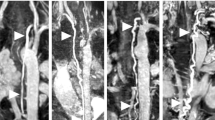Abstract
Purpose
The aim of this study was to compare thoracic duct (TD) configuration depicted by magnetic resonance imaging (MRI) with TD configuration described in the anatomical literature.
Materials and methods
MRI Scans were acquired with a three-dimensional T2-weighted turbo spin echo (TSE) MRI with a two-dimensional prospective acquisition correction (PACE) technique in 63 patients. We found with MRI that TD displacement occurred more on the left side than that reported in the anatomical literature, and this tendency was more marked in elderly patients. In patients with marked leftward TD displacement, the TD configuration on MRI was compared to the descending aortic configuration on chest radiography. The degree of correspondence between the MRI findings and the anatomical literature was assessed by a χ2 goodness-of-fit test, and P < 0.05 indicated a significant difference. The degree of similarity was determined between TD configuration and aortic configuration by Kendall’s coefficient of concordance (W).
Results
On MRI scans the TD was often located to the left of the mid-vertebral line compared to the location reported in the anatomical literature (P < 0.001). Nine patients had marked leftward TD displacement, a configuration similar to that of the descending aorta (W = 1); however, no association with age was established.
Conclusion
The TD configuration depicted by MRI differed from that described in the anatomical literature.
Similar content being viewed by others
References
Williams KR, Burford TH. The management of chylothorax. Ann Surg 1964; 160:131–140.
Udagawa H, Akiyama H, Kirk RM. Oesophageal cancer. In: Kirk RM, editor. General surgical operations. 5th edn. Edinburgh: Elsevier; 2006. p. 139–157.
Okuda I, Udagawa H, Takahashi J, Yamase H, Kohno T, Nakajima Y. Magnetic resonance-thoracic ductography: imaging aid for thoracic surgery and thoracic duct depiction based on embryological considerations. Gen Thorac Cardiovasc Surg 2004;57:640–646.
Gabella G. Cardiovascular system. In: Williams PL, editor. Gray’s anatomy. 38th edn. New York: Churchill Livingstone; 1995. p. 1451–1626.
McVay CB Thoracic cavity and its contents. In: McVay CB, editor. Anson & McVay surgical anatomy. Vol. 1. 6th edn. Philadelphia: Saunders; 1984. p. 385–482.
Adachi B. Der Ductus Thoracicus der Japaner. In: Kihara T, editor. Das Lymphgefässsystem der Japaner. Tokyo: Kenkyusha; 1953. p. 1–83.
Matsushima S, Ichiba N, Hayashi D, Fukuda K. Nonenhanced magnetic resonance lymphoductography: visualization of lymphatic system of the trunk on 3-dimensional heavily T2-weighted image with 2-dimensional prospective acquisition and correction. J Comput Assist Tomogr 2007;31:299–302.
Takahashi H, Kuboyama S, Abe H, Aoki T, Miyazaki M, Nakata H. Clinical feasibility of noncontrast-enhanced magnetic resonance lymphography of the thoracic duct. Chest 2003;124:2136–2142.
Hayashi S, Miyazaki M. Thoracic duct: visualization at non-enhanced MR lymphography: initial experience. Radiology 1999;212:598–600.
Clouse ME, editor. Golden’s diagnostic radiology: clinical lymphography. Baltimore: Williams & Wilkins; 1977.
Rosenberger A, Abrams HL. Radiology of the thoracic duct. Am J Roentgenol Radium Ther Nucl Med 1971;111:807–820.
Kausel HW, Reeve TS, Stein AA, Alley RD, Stranahan A. Anatomic and pathologic studies of the thoracic duct. J Thorac Surg 1957;34:631–641.
Davis HK. A statistical study of the thoracic duct in man. Am J Anat 1915;17:211–242.
Kinmonth JB. Lymphangiography in man; a method of outlining lymphatic trunks at operation. Clin Sci 1952;11:13–20.
Kagami H, Sakai H. The problems in the arrangement of the azygos vein. Okajimas Folia Anat Jpn 1990;67:111–114.
Franquet T. Middle and posterior mediastinal masses. In: Muller NL, Silva CIS, editors. Imaging of the chest. Vol. 2. Philadelphia: Elsevier; 2008. p. 1526–1549.
Crummy AB. The cardiovascular system. In: Juhl JH, Crummy AB, editors. Essentials of radiographic imaging. edn. 6. Philadelphia: Lippincott; 1993. p. 1065–1139.
Dougherty G, Varro J. A quantitative index for the measurement of the tortuosity of blood vessels. Med Eng Phys 2000;22:567–574.
Dobrin PB, Schwarcz TH, Baker WH. Mechanisms of arterial and aneurysmal tortuosity. Surgery 1988;104:568–571.
Mochida M, Sakamoto H, Sawada Y, Yokoyama H, Sato M, Sato H, et al. Visceral fat obesity contributes to the tortuosity of the thoracic aorta on chest radiograph in poststroke Japanese patients. Angiology 2006;57:85–91.
Author information
Authors and Affiliations
Corresponding author
About this article
Cite this article
Okuda, I., Udagawa, H., Hirata, K. et al. Depiction of the thoracic duct by magnetic resonance imaging: comparison between magnetic resonance imaging and the anatomical literature. Jpn J Radiol 29, 39–45 (2011). https://doi.org/10.1007/s11604-010-0515-0
Received:
Accepted:
Published:
Issue Date:
DOI: https://doi.org/10.1007/s11604-010-0515-0




